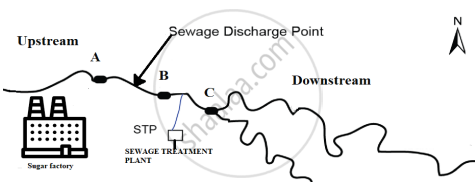Advertisements
Advertisements
Question
What are the various constituents of domestic sewage? Discuss the effects of sewage discharge on a river.
Solution 1
Domestic sewage is the waste originating from the kitchen, toilet, laundry, and other sources. It contains impurities such as suspended solid (sand, salt, clay), colloidal material (fecal matter, bacteria, plastic and cloth fiber), dissolved materials (nitrate, phosphate, calcium, sodium, ammonia), and disease-causing microbes. When organic wastes from the sewage enter the water bodies, it serves as a food source for micro-organisms such as algae and bacteria. As a result, the population of these micro-organisms in the water body increases. Here, they utilize most of the dissolved oxygen for their metabolism. This results in an increase in the levels of Biological oxygen demand (BOD) in river water and results in the death of aquatic organisms. Also, the nutrients in the water lead to the growth of planktonic algal, causing algal bloom. This causes deterioration of water quality and fish mortality.
Solution 2
Domestic sewage contains four kind of impurities:
(i)Suspended solids: They are soil particles such as sand and silt.
(ii)Colloidal particles: They are inorganic and organic materials such as faecal matter, bacteria, paper and cloth.
(iii)Dissolved solids : They are nitrates, phosphates, ammonia, sodium, calcium and other nutrients
(iv)Pathogens : Domestic sewage has pathogens of various diseases such as typhoid, cholera, dysentery, diarrhoea, etc. Effect of sewage discharge on river are:
(i)Eutrophication.
(ii)Growth of pathogenic bacteria.
(iii)Ageing of river where slit and decaying matters start accumulating and filling river.
(iv)Increase in BOD.
(v)Destruction of flora and fauna of that river.
APPEARS IN
RELATED QUESTIONS
Public all over India is very much concerned about the deteriorating air quality in large parts of North India. Alarmed by this situation the Resident's Welfare Association of your locality organized an awareness programme entitled "Bury not burn". They invited you, being a biology student to participate.
(a) How would you justify your arguments that promote burying and discourage burning? (Give two reasons)
(b) With the help of flow charts, one for each practice depict the chain of events that follow.
Water samples were collected at points A, B and C in a segment of a river near a sugar factory and tested for BOD level. The BOD levels of samples A, B and C were 400 mg/L, 480 mg/L and 8 mg/L respectively. What is this indicative of? Explain why the BOD level gets reduced considerably at the collection point C?

Lichens indicate SO2 pollution because they ______.
Algal bloom results in ______.
A high Biological oxygen demand (BOD) indicates that ______.
The polluting strength of sewage is usually characterized by its ______.
Which of the following exhibits biomagnification?
Which one of the following impurities is easiest to remove from wastewater?
Algal blooms impart a distinct colour to water due to ______.
What is cultural eutrophication?
What do you understand by biomagnification?
What are the three major kinds of impurities in domestic wastewater?
Is it true that if the dissolved oxygen level drops to zero, the water will become septic. Give an example which could lower the dissolved oxygen content of an aquatic body.
How has DDT caused decline in bird population?
Observe figure and answer the following questions.

Biomagnification of DDT in an aquatic food chain
- What ecological term is used to describe the DDT accumulation at different trophic levels?
- List any one effect of DDT accumulation on birds
- Will DDT accumulation lead to eutrophication?
- Does it affect the BOD?
- Name disease caused by accumulation of any heavy metal.
